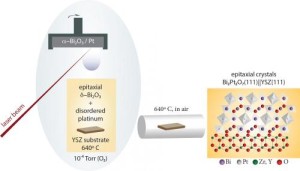
Synthesizing the material as a thin film instead of as a bulk powder opens up new possibilities for fuel cell technology.
Image: A. Gutiérrez-Llorente/Cornell University
Researchers from Cornell University have developed a way to synthesize a new thin-film catalyst to improve efficiency and effectiveness in fuel cells.
For the first time ever, researchers were able to explain the epitaxial thin-film growth of a fundamental electrode component of the fuel cell, which could result in a more effective cathode.
“Up to now, research on oxygen catalysts in thin film form for clean-energy applications has been focused on the perovskite-structured oxides and their structural derivatives,” said lead researcher Araceli Gutierrez-Llorente. “The much less studied cubic pyrochlore structure is an appealing alternative to perovskites for such applications as fuel cell cathodes.”
This from American Institute of Physics:
The pyrochlore in question—Bi2Pt2O7—has previously been successfully synthesized as a nanocrystalline powder. Epitaxial thin films can actually act as more efficient fuel cell catalysts than nanocrystalline powder, but growing Bi2Pt2O7 directly as a film requires oxidizing the platinum metal—a challenging step.
This development opens up new possibilities for fuel cell technology.
Want to join the conversation on fuel cell technology and innovation? Make sure to attend the 227th ECS Meeting this May in Chicago, which will include over 50 topical symposia consisting of over 2,000 technical presentations!

